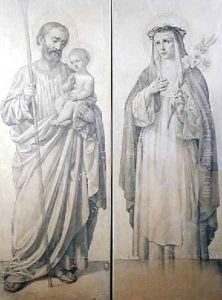V. de Matteis Paintings
Paolo de Matteis was an Italian Baroque painter, born in 1662 in Piano del Cilento, near Salerno. Matteis initially trained under the painter Luca Giordano, one of the most prominent Baroque artists of the time. Under Giordano's guidance, Matteis honed his artistic skills, developing a style characterized by its vibrant color palette and dynamic compositions, hallmarks of the Baroque period.
Matteis's career blossomed after he moved to Rome in the late 1680s, where he became associated with the leading artists and patrons of the era. He garnered the attention of influential figures, including the Medici family in Florence and members of the papal circles. His work was marked by a combination of classical themes and Baroque theatricality, blending traditional iconography with emotional expressiveness.
In the early 1700s, Matteis traveled to Paris, where he was influenced by the French Rococo style, which was beginning to emerge. His work from this period reflects a lighter palette and a more playful approach to composition. Despite his success in France, he returned to Italy, where he continued to work prolifically, producing altarpieces, frescoes, and mythological scenes for churches and palaces throughout the country.
Paolo de Matteis's contributions to the Baroque movement were significant, particularly in Southern Italy. His paintings are characterized by their elegance, clarity of form, and the lively interplay of light and shadow. Despite his success, following his death in 1710, Matteis's reputation was eclipsed by the rising prominence of neoclassicism and changing artistic tastes. However, his works can still be admired in various museums and collections, serving as a testament to the richness and diversity of Baroque art.
